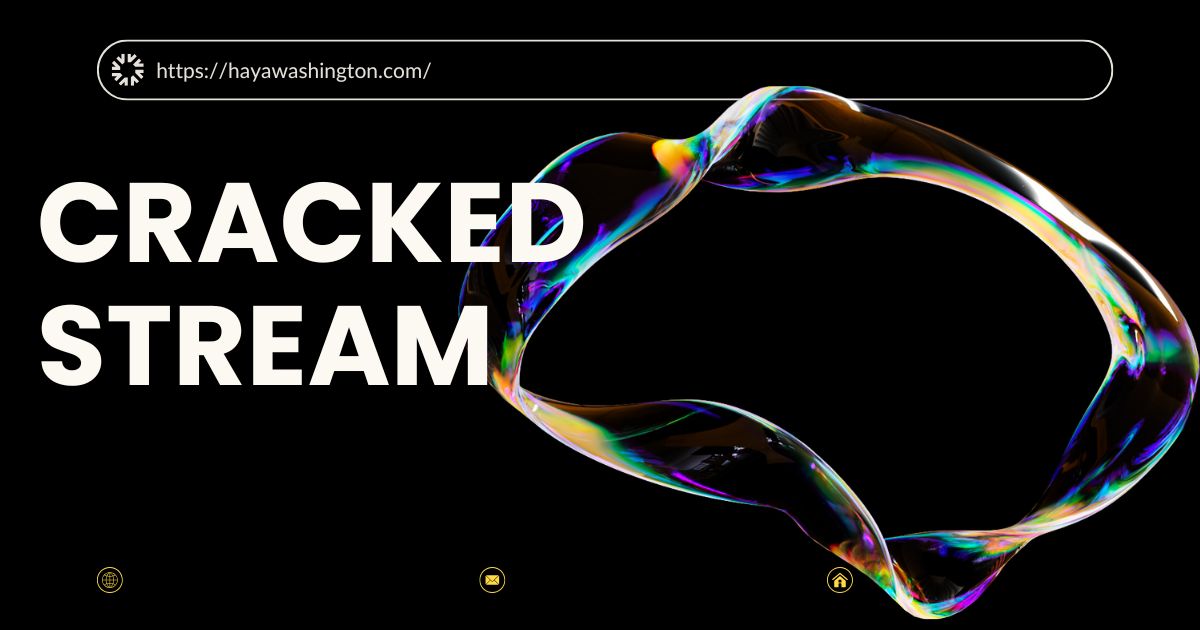In today’s digital age, entertainment is more accessible than ever. With just a few clicks, you can watch the latest movies, binge entire TV series, or tune into live sports from around the world. However, not everyone chooses to access this content through official channels. Many turn to unauthorized platforms—often referred to as “cracked stream” services—to watch their favorite shows for free. While the appeal of cost-free entertainment is understandable, the reality behind these platforms is far more complex and concerning than it may first appear.
This article explores what a cracked stream really is, how it operates, the serious legal and cybersecurity risks it poses, and why users should consider safer, legal alternatives. By the end, you’ll have a clear understanding of why avoiding cracked stream sites isn’t just about following the law—it’s about protecting yourself, your devices, and your personal data.
Table of Contents
What Is a Cracked Stream?
A cracked stream refers to any unauthorized method of accessing copyrighted video content—such as movies, TV shows, live sports, or pay-per-view events—without the permission of the content owner or distributor. These streams are typically hosted on websites or apps that bypass legitimate paywalls, subscriptions, or licensing agreements. The term “cracked” implies that the original digital protections (like encryption or access controls) have been circumvented or “cracked” to allow free public viewing.
Unlike legal streaming services such as Netflix, Hulu, Disney+, or Amazon Prime Video—which pay licensing fees to studios and networks—cracked stream platforms operate outside the law. They often rely on pirated feeds, illegal rebroadcasts, or stolen credentials to deliver content to users. Some may even disguise themselves as legitimate services, using familiar logos or user interfaces to appear trustworthy.
These platforms are not limited to obscure corners of the internet. Many are easily found through simple web searches, social media links, or forum recommendations. They may offer high-definition video, multiple language options, and even live chat features—making them seem like polished, professional services. But beneath the surface lies a web of illegality and risk.
How Do Cracked Stream Services Work?
Understanding the mechanics behind a cracked stream helps clarify why they’re so problematic. At their core, these services rely on three main methods to deliver unauthorized content:
1. Content Scraping and Rehosting
Some cracked stream sites scrape video files from legitimate platforms or private servers and rehost them on their own domains. This is often done using automated bots that detect newly uploaded content and copy it within minutes. Once rehosted, the content is made available to anyone who visits the site—no subscription required.
2. Illegal IPTV Reselling
Another common method involves Internet Protocol Television (IPTV). While legal IPTV services exist (like Sling TV or YouTube TV), illegal IPTV providers offer thousands of channels—including premium sports and movie networks—for a fraction of the official price. These services often use stolen or shared subscription credentials or tap into unsecured broadcast feeds. Users may pay a small monthly fee, mistakenly believing they’re getting a “discounted” legal service, when in fact they’re funding piracy.
3. Peer-to-Peer (P2P) Streaming
Some cracked stream platforms use P2P technology, similar to file-sharing networks like BitTorrent. Instead of downloading a full file, users stream content in real time while simultaneously uploading pieces of it to other users. This decentralized model makes it harder for authorities to shut down the source—but it also exposes users to malware and legal scrutiny.
Regardless of the method, all cracked stream services share one thing in common: they distribute content without authorization, violating copyright laws in most countries.
The Legal Consequences of Using Cracked Streams
Many users assume that since they’re only “watching” and not “downloading,” they’re not breaking the law. Unfortunately, this is a dangerous misconception.
Copyright Infringement
Watching a cracked stream constitutes copyright infringement in many jurisdictions, including the United States, the United Kingdom, Canada, and the European Union. While enforcement often targets distributors rather than individual viewers, legal precedents do exist where users have faced fines or lawsuits.
For example, in the U.S., the Copyright Act allows rights holders to seek statutory damages of up to $150,000 per work infringed. Although rare for casual viewers, the risk increases if you’re repeatedly accessing pirated content or sharing links publicly.
ISP Monitoring and Warnings
Internet Service Providers (ISPs) often cooperate with copyright enforcement agencies. If you’re detected accessing a known cracked stream site, your ISP may send you a warning notice. Repeated offenses could lead to throttled internet speeds, account suspension, or even legal action in extreme cases.
International Variations
Laws vary by country. In some places, like Germany or France, users have been fined hundreds of euros for streaming pirated content. In others, like India or parts of Southeast Asia, enforcement may be less strict—but that doesn’t make the activity legal. As global anti-piracy efforts intensify, even regions with lax enforcement may see stricter policies in the future.
Cybersecurity Risks of Cracked Stream Sites
Beyond legal issues, cracked stream platforms pose serious cybersecurity threats. Because they operate outside regulated environments, they lack the security standards of legitimate services.
Malware and Viruses
Many cracked stream sites are riddled with malicious ads (malvertising) or hidden scripts that install malware on your device without your knowledge. This malware can:
- Steal login credentials and banking information
- Hijack your webcam or microphone
- Enlist your device in a botnet for launching cyberattacks
- Encrypt your files for ransom (ransomware)
A 2023 study by cybersecurity firm Kaspersky found that over 60% of piracy-related websites attempted to install malware on visitors’ devices.
Phishing Scams
Some fake streaming sites mimic legitimate platforms to trick users into entering their Netflix, Amazon, or PayPal credentials. Once harvested, this information is sold on the dark web or used to make unauthorized purchases.
Data Tracking and Privacy Violations
Even if a cracked stream site doesn’t install malware, it may still track your browsing behavior, IP address, and device information. This data is often sold to third-party advertisers or data brokers—without your consent. Unlike legal services bound by privacy laws like GDPR or CCPA, pirate sites operate with zero accountability.
Impact on the Entertainment Industry
Using a cracked stream might feel like a victimless crime, but it has real-world consequences for creators, actors, crew members, and the entire entertainment ecosystem.
Lost Revenue
The global film and television industry loses billions of dollars annually due to piracy. According to the U.S. Chamber of Commerce, online piracy costs the U.S. economy an estimated $29.2 billion in lost revenue each year and puts nearly 230,000 jobs at risk.
When viewers opt for cracked stream services instead of paying for content, studios earn less. This directly affects budgets for future productions, leading to fewer high-quality shows, canceled series, or reduced pay for behind-the-scenes workers.
Stifled Innovation
Revenue from legal streaming funds innovation—better special effects, diverse storytelling, improved accessibility features, and global distribution. Piracy undermines this cycle. Smaller studios and independent filmmakers, who rely heavily on every dollar of income, are hit especially hard.
Ethical Considerations
Behind every movie or show are hundreds of people—writers, directors, editors, costume designers, sound engineers—who depend on fair compensation. Choosing a cracked stream over a legal option disrespects their labor and devalues creative work.
Why Are Cracked Streams So Popular?
Despite the risks, cracked stream services remain widely used. Several factors contribute to their popularity:
Cost
Subscription fatigue is real. With dozens of streaming platforms—each with its own monthly fee—many consumers feel overwhelmed. A single household might pay $50–$100 per month for multiple services. Cracked stream sites offer a tempting “free” alternative.
Content Availability
Not all content is available globally due to licensing restrictions. A show popular in the U.S. might be unavailable in Brazil or Japan. Frustrated viewers often turn to cracked stream sites to access region-locked content.
Convenience
Some users dislike managing multiple accounts or navigating fragmented platforms. Pirate sites often aggregate content from various sources into one easy-to-use interface—making them appear more convenient than legal options.
However, convenience and cost savings should never come at the expense of safety, legality, or ethics.
Legal and Safe Alternatives to Cracked Streams
The good news is that there are plenty of affordable, legal ways to enjoy entertainment without resorting to a cracked stream.
1. Free Ad-Supported Streaming TV (FAST)
Services like Tubi, Pluto TV, Crackle, and The Roku Channel offer thousands of movies and TV shows completely free—supported by ads, not subscriptions. While they may not have the latest blockbusters, their libraries are extensive and constantly updated.
2. Library and Educational Resources
Public libraries often provide free access to streaming platforms like Kanopy and Hoopla, which feature indie films, documentaries, and classic cinema. All you need is a library card.
3. Rotating Subscriptions
Instead of subscribing to five services at once, consider rotating them monthly. Watch everything you want on Hulu in January, switch to Max in February, and so on. This keeps costs manageable while staying legal.
4. Bundled Deals
Many providers offer bundles. For example, Disney+/Hulu/ESPN+ costs less together than separately. Mobile carriers and internet providers sometimes include streaming subscriptions as part of service packages.
5. Official Free Trials
Most legal platforms offer 7–30 day free trials. While not a long-term solution, they’re perfect for catching a specific show or event without paying.
By using these alternatives, you support creators, protect your devices, and enjoy peace of mind.
How to Identify and Avoid Cracked Stream Sites
Not all streaming sites are created equal. Here’s how to spot a cracked stream and steer clear:
- Too-good-to-be-true offers: “All premium channels for $5/month” is a red flag.
- Poor website design: Misspellings, excessive pop-ups, or broken links often indicate illegitimacy.
- No clear company info: Legitimate services list contact details, terms of service, and privacy policies.
- Requests for unusual payment methods: Gift cards, cryptocurrency, or wire transfers are common in illegal operations.
- URLs with random numbers or misspelled brand names: e.g., “netflixx-free[.]com” or “huluhd123[.]org”.
When in doubt, stick to well-known platforms or verify a service through official app stores or trusted review sites.
The Future of Streaming and Piracy
As technology evolves, so do both streaming services and piracy tactics. However, the trend is moving toward greater accessibility and affordability:
- Consolidation: Major studios are merging platforms (e.g., Discovery+ and HBO Max becoming Max) to simplify access.
- Global Licensing: More content is becoming available worldwide, reducing the need for region-hopping.
- Anti-Piracy Measures: Advanced digital fingerprinting, AI monitoring, and international cooperation are making it harder for cracked stream operations to survive.
Consumers also have more power than ever to demand fair pricing and better user experiences. By choosing legal options, you help shape a healthier entertainment landscape.
Conclusion
A cracked stream may seem like a harmless shortcut to free entertainment, but the truth is far more serious. These unauthorized platforms violate copyright laws, expose users to malware and fraud, and harm the creative professionals who bring stories to life. While the temptation to avoid subscription fees is understandable, the risks simply aren’t worth it.
Thankfully, numerous legal, safe, and often free alternatives exist. From ad-supported platforms to library partnerships and smart subscription strategies, you don’t need to compromise your values or security to enjoy great content. By making informed choices, you protect yourself and contribute to a sustainable future for film, television, and digital media.
The next time you’re tempted to click on a suspicious link promising a “free” live sports event or the latest blockbuster, remember: if it sounds too good to be true, it probably is. Choose wisely, stream legally, and leave cracked stream services where they belong—in the shadows of the internet.












